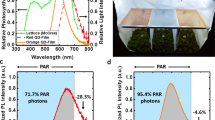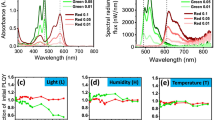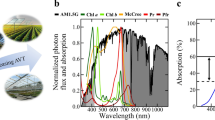Abstract
Improving photosynthesis and light capture increases crop yield and paves a sustainable way to meet the growing global food demand. Here we introduce a spectral-shifting microphotonic thin film as a greenhouse envelope that can be scalably manufactured for augmented photosynthesis. By breaking the intrinsic propagation symmetry of light, the photonic microstructures can extract 89% of the internally generated light and deliver most of that in one direction towards photosynthetic organisms. The microphotonic film augments lettuce production by more than 20% in both indoor facilities with electric lighting and in a greenhouse with natural sunlight, offering the possibility of increasing crop production efficiency in controlled environments.
This is a preview of subscription content, access via your institution
Access options
Access Nature and 54 other Nature Portfolio journals
Get Nature+, our best-value online-access subscription
$29.99 / 30 days
cancel any time
Subscribe to this journal
Receive 12 digital issues and online access to articles
$119.00 per year
only $9.92 per issue
Buy this article
- Purchase on Springer Link
- Instant access to full article PDF
Prices may be subject to local taxes which are calculated during checkout




Similar content being viewed by others
Data availability
All presented data are available upon reasonable request from the authors. Source data are provided with this paper.
References
Johnson, Z. & Barber, R. T. The low-light reduction in the quantum yield of photosynthesis: potential errors and bias when calculating the maximum quantum yield. Photosynth. Res. 75, 85–95 (2003).
Ooms, M. D., Dinh, C. T., Sargent, E. H. & Sinton, D. Photon management for augmented photosynthesis. Nat. Commun. 7, 12699 (2016).
Zhang, M., Whitman, C. M. & Runkle, E. S. Manipulating growth, color, and taste attributes of fresh cut lettuce by greenhouse supplemental lighting. Sci. Hortic. 252, 274–282 (2019).
Pinho, P., Jokinen, K. & Halonen, L. Horticultural lighting—present and future challenges. Light. Res. Technol. 44, 427–437 (2012).
Stober, K., Lee, K., Yamada, M. & Pattison, M. Energy Savings Potential of SSL in Horticultural Applications (US Department of Energy, 2017); https://doi.org/10.2172/1418429
McCree, K. J. The action spectrum, absorptance and quantum yield of photosynthesis in crop plants. Agric. Meteorol. 9, 191–216 (1972).
Wondraczek, L. et al. Solar spectral conversion for improving the photosynthetic activity in algae reactors. Nat. Commun. 4, 2047 (2013).
Mohsenpour, S. F., Richards, B. & Willoughby, N. Spectral conversion of light for enhanced microalgae growth rates and photosynthetic pigment production. Bioresour. Technol. 125, 75–81 (2012).
Detweiler, A. M. et al. Evaluation of wavelength selective photovoltaic panels on microalgae growth and photosynthetic efficiency. Algal Res. 9, 170–177 (2015).
El-Bashir, S., Al-Harbi, F., Elburaih, H., Al-Faifi, F. & Yahia, I. Red photoluminescent PMMA nanohybrid films for modifying the spectral distribution of solar radiation inside greenhouses. Renew. Energy 85, 928–938 (2016).
Loik, M. E. et al. Wavelength‐selective solar photovoltaic systems: powering greenhouses for plant growth at the food–energy–water nexus. Earths Future 5, 1044–1053 (2017).
Campbell, P. & Green, M. A. Light trapping properties of pyramidally textured surfaces. J. Appl. Phys. 62, 243–249 (1987).
Atwater, H. A. & Polman, A. Plasmonics for improved photovoltaic devices. Nat. Mater. 9, 205–213 (2010).
Meinardi, F., Bruni, F. & Brovelli, S. Luminescent solar concentrators for building-integrated photovoltaics. Nat. Rev. Mater. 2, 17072 (2017).
Zhmakin, A. I. Enhancement of light extraction from light emitting diodes. Phys. Rep. 498, 189–241 (2011).
Zhang, Q. et al. Light out‐coupling management in perovskite LEDs—what can we learn from the past? Adv. Funct. Mater. 30, 2002570 (2020).
Schnitzer, I., Yablonovitch, E., Caneau, C., Gmitter, T. & Scherer, A. 30% external quantum efficiency from surface textured, thin‐film light‐emitting diodes. Appl. Phys. Lett. 63, 2174–2176 (1993).
Winston, R., Minano, J. C. & Benitez, P. G. Nonimaging Optics 1st edn (Academic Press, 2005).
Lee, S. J. Analysis of light-emitting diode by Monte-Carlo photo simulation. Appl. Opt. 40, 1427–1437 (2001).
Liu, Z., Wang, K., Luo, X. & Liu, S. Precise optical modeling of blue light-emitting diodes by Monte Carlo ray-tracing. Opt. Express 18, 9398–9412 (2010).
Corrado, C. et al. Optimization of gain and energy conversion efficiency using front-facing photovoltaic cell luminescent solar concentratordesign. Sol. Energy Mater. Sol. Cells 111, 74–81 (2013).
Wang, J., Lu, W., Tong, Y. & Yang, Q. Leaf morphology, photosynthetic performance, chlorophyll fluorescence, stomatal development of lettuce (Lactuca sativa L.) exposed to different ratios of red light to blue light. Front. Plant. Sci. https://doi.org/10.3389/fpls.2016.00250 (2016).
Dougher, T. A. O. & Bugbee, B. Differences in the response of wheat, soybean and lettuce to reduced blue radiation. Photochem. Photobiol. 73, 199–207 (2001).
Kim, H. H., Goins, G., Wheeler, R. & Sager, J. Green light supplementation for enhanced lettuce growth under red and blue light-emitting diodes. Hortscience 39, 1617–1622 (2004).
Park, Y. & Runkle, E. S. Far-red radiation promotes growth of seedlings by increasing leaf expansion and whole-plant net assimilation. Environ. Exp. Bot. 136, 41–49 (2017).
Pennisi, G. et al. Resource use efficiency of indoor lettuce (Lactuca sativa L.) cultivation as affected by red:blue ratio provided by LED lighting. Sci. Rep. 9, 14127 (2019).
Naznin, M. T., Lefsrud, M., Gravel, V. & Azad, M. O. K. Blue light added with red LEDs enhance growth characteristics, pigments content, and antioxidant capacity in lettuce, spinach, kale, basil, and sweet pepper in a controlled environment. Plants 8, 93 (2019).
Griffini, G., Levi, M. & Turri, S. Novel crosslinked host matrices based on fluorinated polymers for long-term durability in thin-film luminescent solar concentrators. Sol. Energy Mater. Sol. Cells 118, 36–42 (2013).
Erickson, C. S. et al. Zero-reabsorption doped-nanocrystal luminescent solar concentrators. ACS Nano 8, 3461–3467 (2014).
Wang, T. et al. Luminescent solar concentrator employing rare earth complex with zero self-absorption loss. Sol. Energy 85, 2571–2579 (2011).
Currie, M. J., Mapel, J. K., Heidel, T. D., Goffri, S. & Baldo, M. A. High-efficiency organic solar concentrators for photovoltaics. Science 321, 226–228 (2008).
Haxo, F. T. Photosynthetic action spectra of marine algae. J. Gen. Physiol. 33, 389–422 (1950).
LaVigne, A. W. The Next Farm Bill: Technology & Innovation in Specialty Crops (American Seed Trade Association, 2017); https://www.betterseed.org/wp-content/uploads/Andrew-LaVigne-House-Ag-testimony-7-12-17.pdf
Meng, Q., Boldt, W. J. & Runkle, E. Blue radiation interacts with green radiation to influence growth and predominantly controls quality attributes of lettuce. J. Am. Soc. Hortic. Sci. 145, 75–87 (2020).
South, P. F., Cavanagh, A. P., Liu, H. W. & Ort, D. R. Synthetic glycolate metabolism pathways stimulate crop growth and productivity in the field. Science 363, eaat9077 (2019).
Kutzbach, L. et al. CO2 flux determination by closed-chamber methods can be seriously biased by inappropriate application of linear regression. Biogeoscience 4, 1005–1025 (2007).
Jensen, L. S. et al. Soil surface CO2 flux as an index of soil respiration in situ: a comparison of two chamber methods. Soil Biol. Biochem. 28, 1297–1306 (1996).
Cabrera, M. L., Kissel, D. E. & Vigil, M. F. Nitrogen mineralization from organic residues: research opportunities. J. Environ. Qual. 34, 75–79 (2005).
Acknowledgements
This work is supported by the Gordon and Betty Moore Foundation under grant number 6884 and the National Institute of Food and Agriculture under grant number 2017-07652. We thank M. Rhode and J. Uhrich for assisting with precision machining of the replica moulds; J. Chalmers, K. Yang, Y. Zhai and I. Berman for assisting with blade coating; and N. DuRussel for providing greenhouse technical assistance. We are grateful to J. Klausner, A. Benard and M. Adeney for fruitful discussions about greenhouse technologies and agricultural practices.
Author information
Authors and Affiliations
Contributions
X.Y. and R.Y. conceived the idea. X.Y. and L.S. designed the experiments. L.S. and R.L. conducted the structure design and developed the simulation methods. L.S. fabricated the films and performed the characterizations with assistance from Y.X., D.R. and R.L. L.S. built the setup and performed indoor growth of lettuce with assistance from R.L., Y.G. and Y.X. L.S., E.J.S., Y.P. and R.L. performed the experiments in the research greenhouse. X.Y., L.S. and E.S.R. analysed the data. X.Y. and L.S. drafted the manuscript with input from all authors. X.Y. guided the research.
Corresponding author
Ethics declarations
Competing interests
The authors declare no competing interests.
Additional information
Peer review information Nature Food thanks Houcheng Liu, Francesco Orsini and the other, anonymous, reviewer(s) for their contribution to the peer review of this work.
Publisher’s note Springer Nature remains neutral with regard to jurisdictional claims in published maps and institutional affiliations.
Supplementary information
Supplementary Information
Supplementary Figs. 1–30, Methods, Discussion and Tables 1–6.
Supplementary Video 1
Comparative growth video of ‘Buttercrunch’ lettuce
Supplementary Data 1
Growth Data Log-Greenhouse
Supplementary Data 2
Growth Data Log-Outdoor
Source data
Source Data Fig. 1
Source data of Fig. 1b,c,j,and k
Source Data Fig. 2
Source data of Fig. 2b-j
Source Data Fig. 3
Source data of Fig. 3
Source Data Fig. 4
Source data of Fig. 4
Rights and permissions
About this article
Cite this article
Shen, L., Lou, R., Park, Y. et al. Increasing greenhouse production by spectral-shifting and unidirectional light-extracting photonics. Nat Food 2, 434–441 (2021). https://doi.org/10.1038/s43016-021-00307-8
Received:
Accepted:
Published:
Issue Date:
DOI: https://doi.org/10.1038/s43016-021-00307-8
This article is cited by
-
Growth, morphology, and photosynthetic activity of Chinese cabbage and lettuce grown under polyethylene and spectrum conversion films
Horticulture, Environment, and Biotechnology (2023)
-
Solar spectral management for natural photosynthesis: from photonics designs to potential applications
Nano Convergence (2022)
-
Photonics and thermodynamics concepts in radiative cooling
Nature Photonics (2022)
-
Improving light management in lettuce crops
Nature Food (2021)



